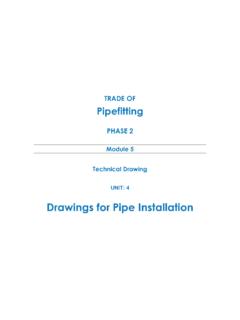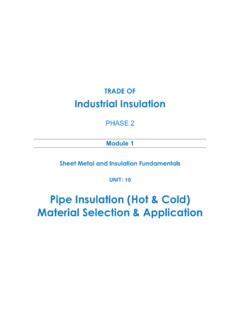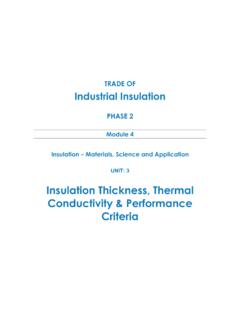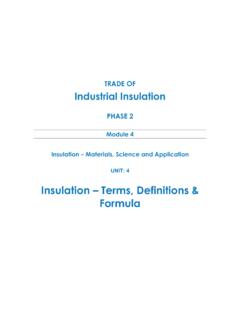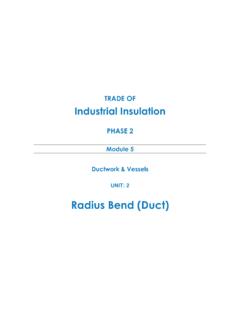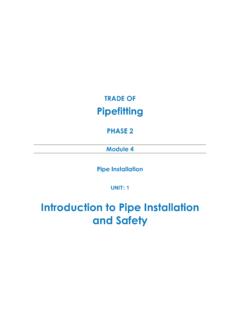Transcription of M3 U2 Piping Components and fittings - eCollege
1 TRADE OF. Pipefitting PHASE 2. Module 3. Pipe Processes UNIT: 2. Piping Components and fittings Produced by In cooperation with subject matter expert: Finbar Smith SOLAS 2014. Module 3 Unit 2 Piping Components and fittings Table of Contents Unit Objective .. 1. Learning Outcome .. 2. Pipe fittings .. 3. Introduction to Pipe fittings .. 3. Identifying Basic Pipe fittings .. 4. Elbow .. 4. Tee .. 4. Cross .. 5. Reducer .. 5. Cap or Plug .. 6. fittings for Pipe Joints .. 7. How fittings are Connected to Pipes .. 7. Screwed Unions .. 7. Flanges .. 7. Valves for Piping 11. Valves for Piping 11. Ball 11. Butterfly Valve .. 12. Globe Valve.
2 12. Check Valve .. 13. Diaphragm Valve .. 14. Process Control Valves .. 15. Safety Relief Valve .. 17. Handling and Installing Valves .. 19. Valve Nameplates .. 19. Storage and Handling of 20. Installation Instructions for Valves .. 20. Maintenance of Valves .. 22. Pumps for Piping Systems .. 23. Pumps for Piping Systems .. 23. Useful Terminology when Dealing with Liquid Pumps .. 24. Centrifugal Pump .. 25. Rotary Lobe 26. Air Operated Diaphragm Pump .. 27. Instruments for Piping Systems .. 28. Instruments for Piping Systems .. 28. Pressure Measurement .. 28. Temperature 29. Flow Measurement .. 30. Exercises .. 31. Additional Resources.
3 32. Pipe fitting Phase 2 Revision September 2014. Module 3 Unit 2 Piping Components and fittings Unit Objective There are seven Units in Module 3 for Pipe Processes. Unit 1 focuses on Piping Materials, Unit 2; Piping Components and fittings , Unit 3; Bill of Materials, Unit 4; Pipe Preparation, Unit 5; Pipe Joining, Unit 6; Pipe threading and testing and Unit 7 Pipe bending. Module 3. Pipe Processes Unit 1 Unit 2 Unit 3 Unit 4 Unit 5 Unit 6 Unit 7. Pipe Materials Piping Bill of Pipe Pipe Joining Pipe Pipe Bending Component Materials Preparation Threading and fittings and Testing In this unit you will be introduced to the different Components such as fittings , valves pumps and instruments used in Piping systems.
4 This unit will look at how they are classified and why they are selected for different applications and services. Pipe fitting Phase 2 Revision September 2014. 1. Module 3 Unit 2 Piping Components and fittings Learning Outcome By the end of this unit each apprentice will be able to: Identify the various types of pipe joining fittings used in Piping systems. flanges threaded welded Explain the purpose of valves and where they are normally positioned in Piping systems. Identify different types of valves for the following functions: Stop valves for flow isolation Check valves Flow regulating valves Control valves Safety relief valves Identify the common information identified on a valve name plate Explain the correct procedure for storing and handling of valves.
5 Identify the most common types of pumps and their applications in Piping systems. Centrifugal pump Rotary lobe pump Air operated diaphragm pump Identify the various types of gauges/meters used in pipe installations pressure gauges temperature gauges flow meters Pipe fitting Phase 2 Revision September 2014. 2. Module 3 Unit 2 Piping Components and fittings Pipe fittings Key Learning Points Identify the basic pipe fittings used for pipe and tube systems Identify the function of each fitting and any special installation techniques if applicable Introduction to Pipe fittings fittings are used in pipe and plumbing systems to connect straight pipe or tubing sections, to adapt to different sizes or shapes, to branch or re-direct the Piping system and if necessary to provide a jointing method if 2 dissimiliar Piping materials are used in the one system.
6 fittings for pipe and tubing are most often made from the same base material as the pipe or tubing being connected, , stainless steel, steel, copper or plastic. However, any material that is allowed by code may be used, but must be compatible with the other materials in the system, the fluids being transported, and the temperatures and pressures inside and outside of the system. For example, brass-bodied fittings are common in otherwise copper Piping and plumbing systems. The photographs below show some common fittings that are used in Piping systems. Screwed stainless steel and butt weld mild steel fittings Pipe fitting Phase 2 Revision September 2014.
7 3. Module 3 Unit 2 Piping Components and fittings Identifying Basic Pipe fittings fittings for Piping systems can be expensive and require a proportionally large labour element to install, therefore correct selection and use is of vital importance to a well installed Piping system. Every type of Piping material has a range of fittings that can be used with it and some Piping materials can have multiple different ranges of fittings that can be used. For example copper Piping systems can be installed by bending the pipe and therefore using no elbows, using soldered copper fittings or compression brass fittings depending on the type of service being transferred in the copper pipe.
8 fittings are available with ends to match the Piping installation therefore the following information will not differentiate between welded , threaded or compression but will concentrate on the orientation and the use of the fitting . The most common type of pipe fittings are: Elbow Tee Cross Reducer Cap Union Elbow A pipe fitting installed between two lengths of pipe or tube allowing a change of direction, usually 90 or 45 . The ends may be machined for butt welding, threaded (usually female), or socketed, etc. When the two ends differ in size, it is called a reducing or reducer elbow. Most elbows are available in short radius or long radius of types.
9 The short radius elbows have a center to end distance equal to the nominal diameter, while the long radius is times the nominal diameter. Elbows used on powder transfer systems have a much longer radius (radius of bend can be 10 times the nominal diameter of the pipe) to ensure smooth flow, reduce wear to both product and Piping and to reduce the chance of getting blockages. 90 Elbow 45 Elbow Tee A tee is used to either combine or split a fluid flow. Most common are equal tees which have the same body and branch diameter but there is also a wide range of reducing tees where either the branch or the body is a different diameter relative to each other.
10 Pipe fitting Phase 2 Revision September 2014. 4. Module 3 Unit 2 Piping Components and fittings A swept tee is where the branch enters the body at an arc and is used to minimise the frictional losses and promote flow in the system. A wye tee is where the branch is stabbed into the body at an angle and is usually used where the branch is a smaller diameter than the main pipe. Difference between a swept tee and a wye tee Cross A cross has one inlet and three outlets, or vice versa and like tees come in equal and reducing forms. A cross is more expensive than two tees but has the advantage of reduced space and requires less labour to install.
